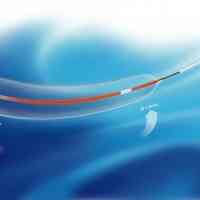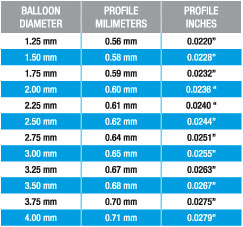- Progressive balloon Diameter. Tapered design matching with coronary artery.
- Excellent navigability properties and balanced pushability, trackability and crossability.
- Ideal for CTO and TIGHT lesions. Two small diameters in one single balloon 1.25mm distal and 1.50 mm proximal. Low profiles - tip entry and balloon crossing. Very thin balloon wall (0.008 mm), very flexible, resistant, fast deflation time.
- Selective use on bifurcated and long lesions. Progressive balloon diameter and wide selection of balloon length - from 15 mm to 40 mm.
- Deliver central and uniform dilatation with less risk to cause edge dissection. Balloon distal transition angle design: tapered shoulders at 42º.
- Conical stent post-dilatation. Balloon wall very thin, flexible and resistant.
Freedom of motion of guide wire at high pressure balloon inflation. No risk of guide wire colapse. Patented design of inner tube at distal catheter segment. Avoiding balloon “dog bone” effect and potential intima’s injuries. Controlled balloon growth even at high inflation pressures. Low friction during navigation and crossability. Highly efficient hidrophilic balloon and distal shaft coating.
- PTCA Balloon Catheter Rapid Exchange System (RX)
- Semi-Compliant Balloon
- Balloon material: Polyamide
- Conic balloon diameters: Proximal segment wider than distal segment.
- Balloon transition Angles: Tapered shoulders at 42º
- Balloon inflations pressures: Nominal 8 ATM/Bars.
- Rated Burst Pressure (RBP): 18 ATM/Bars (16 ATM/Bars > 4.0mm)
- Catheter tip entry profile 0.016”
- Catheter lenght: 140 cms
- Catheter shaft diameters: 1.9 FR (próximal) and 2.4 FR distal
- Compatible Guide wire 0.014”
- Minimal Guiding catheter compatible: 5 FR (0.058mm)
- Kissing Ballooon technique: 2 Conic One balloons on 6 FR guiding catheter







